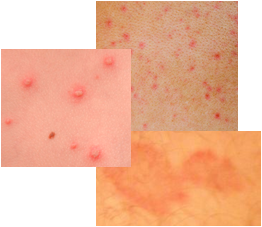Honey Bee Sting Symptoms
Visit this
PICTURES OF RASHES PAGE
In order to avoid serious complications from a honey bee sting or bumble bee stings, it is important to become familiar with the skin symptoms that can occur with a bee sting. Proper symptom diagnosis will help the individual decide which bee sting treatment is appropriate.
Bee Sting Symptoms
Before discussing a bee sting treatment, it is useful to describe the reactions or symptoms that individuals can experience when a bee stings.
A bumble or honey bee can cause quite mild non-life threatening symptoms or much more serious health problems. The greatest risks that can occur from bee stings are an allergic reaction (which could be fatal in some individuals ) or infection.
Minor Bee Sting Reaction
The symptoms of a minor reaction vary from individual to individual. Usually, they consist of localized skin symptoms and these types of reactions require only a minor bee sting treatment. The minor symptoms can include the following:
- immediate pain at the affected skin site that is variable in intensity - from moderate to quite painful for a few hours
- swelling and warmth at and around the skin area that was stung
- the area of the affected skin might also become red and a small pimple-like bump may develop
- itching at and around the area of the honeybee sting
- a small amount of bleeding or drainage at the sting site
- the swelling and itching of the skin may persist for up to one week
- a large (greater than 4 inches across) local reaction on the skin may develop over the next day or two; if it persists for more than 4 or 5 days, then medical advice should be pursued
- a reaction may occur for a couple of days that involves a low-grade fever, accompanied by mild nausea, aches, and tiredness
- a bacterial infection may occur during this time period; although it is uncommon it may develop due to excessive scratching or failure to remove the stinger
- some skin hives may develop if there is a mild sensitivity to the venom of the honey bee or bumblebee
Major Bee Sting Reaction
A major reaction to a bumble or honey bee sting occurs because the individual has an allergy to the venom injected by the bee. In this case, the symptoms are more severe and a bee sting treatment is essential as it could be the difference between life and death. The more severe symptoms that may occur if one is allergic to a sting are characterized by:
- a body skin rash or severe hives all over the skin on the body with itch
- flushing of the skin
- headache
- fever
- severe swelling of the face, lips, tongue, and elsewhere on the body
- painful joints and muscle cramps especially in the abdominal area
- nausea and possible vomiting
- increased heart rate
- difficulty swallowing and difficulty speaking or hoarseness
- coughing, tickling of the throat, chest tightness, and problems breathing properly or wheezing because of swelling of the throat and constriction of the air passages leading to the lungs (anaphylaxis)
- excessive sweating, weakness, faintness, drowsiness, or unconsciousness
- shock and drop in blood pressure
- anxiety
Bumble or Honey Bee Sting Prevention
In order to prevent a honey bee or bumble bee sting and the need for a subsequent bee sting treatment, proper prevention steps must be followed.
- Avoid flower gardens, orchards, or wherever honey bees or bumble bees are more likely to reside.
- Cover up the body when in areas where bees are more likely to reside. This can be easily done by wearing long pants, a long sleeve shirts, shoes, and a hat.
- Wear light colored clothing because it attracts less bees than dark colored clothing.
- Avoid using perfumes and colognes as well as scented soaps, deodorants, suntan lotions, shampoo, and other hair products when outdoors. Also avoid bananas and banana scented creams, etc. Other strong smells such as sweat will attract bees.
- Some foods, especially sweet foods, will attract bees to your area. Therefore, avoid open garbage areas, keep food covered, do not leave open cans of soft drinks lying around, and check before drinking from them.
- Stay calm when a bee comes near. A bee sting is more likely to occur if the bee is agitated because of sudden movements or arms trying to swot at it. For a bee landing on the skin, a gentle blowing may encourage the bee to leave without incident. If there is panic and movement, a bee sting will occur and then a bee sting treatment will be necessary.
- Bees release a chemical (pheromone) when they sting to signal other bees from a nearby hive or swarm to attack. Therefore, in order to avoid the need for a significant bee sting treatment, it is best to jump into water to avoid a swarm or run into a sheltered area as far away from the hive or swarm as possible. The chemical does not rinse off easy and therefore, a good washing of the stung area or change of clothing is recommended.
- If you want to remove a bee nest, contact a professional to avoid being stung. Or if you wait, bees will not likely reuse a old nest the following year.
Related information:
bee stings | honey bee sting symptoms | treatments
